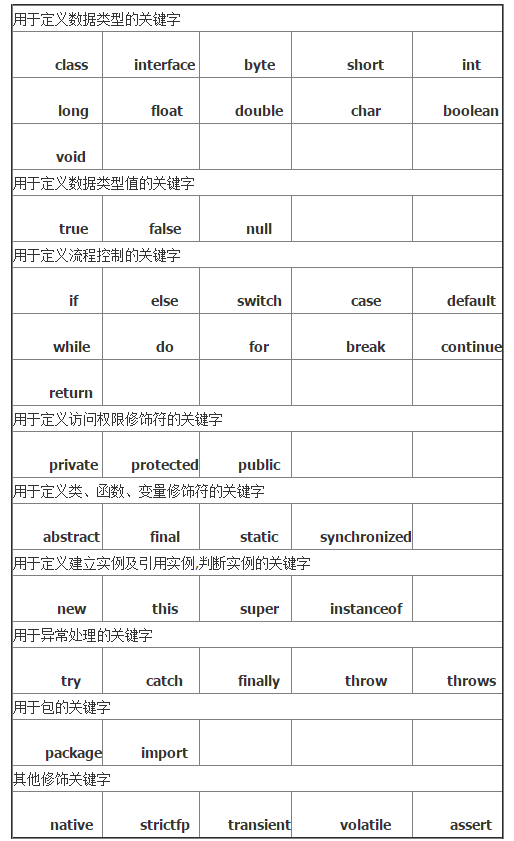
Java basic introductory essay (2) JavaSE version 1. Java language-keywords Keywords: words given special meaning by the Java language, characterized by the fact that all letters are lowercase.
Arrangement of keywords involved in java:
Keywords used to define data types

2.Java language-identifier identifiers only have two symbols that meet the requirements: _ and $, as well as 0-9 and 26 A combination of letters, requiring non-keywords that cannot begin with a number!
3. Java language - comments In addition to common single-line comments and multi-line comments, a Java-specific comment method is recorded here - document comments, which can embody explanatory text on the written source code, and are different from multi-line comments. The difference is that the java tool javadoc tool can be used to extract document comments in java and generate an instruction manual (html). The structure is as follows:
/**
Documentation comments
*/
4. Java language-base conversion octal number, In fact, 3 binary digits in binary form one octal digit;
A hexadecimal number actually means 4 binary digits in binary form one hexadecimal digit.
5. Java language - the binary representation of a negative number. The representation of a negative number is actually the binary inversion of the positive number plus 1;
Rule: The highest binary digit of any negative number is 1.
6.Java language-variables. Variables have three elements: type, name, and value.
The scope of the variable (valid between a pair of {}).
Data types include basic data types (integer types [integer types (byte, short, int, long), floating point types (float, double)], character types (char), Boolean types (boolean)), reference data types (Class, interface, array ([]))
Default for integers: int, default for decimals: double
7. Java language - type conversion automatic type conversion (implicit type conversion): when operating on numerical data , different data types will be automatically type promoted and become the one that occupies a larger type!
Forced type conversion (explicit type conversion)
The internal principle of adding characters and numbers to obtain a numerical result is based on your encoding table, or the international standard code table (unicode)!
Note: byte b = 4; b = 3+7; System.out. println(b); //This can be run because the operation on the right side of the variable is an operation between constants, as long as it is within the value range of byte feasible!
byte b = 4;byte b1 = 3;byte b2= 7; System.out.println(b); //This will report an error, because the operation on the right side of the variable is an operation between variables, which is undeterminable!
8. Java Language - Operators Note that the strongly typed language in Java will omit the number of digits when calculating division operations, for example: int x=6370; x=x/1000*1000; System.out.println(“x” ); The operation result is 6000;
When assigning operations and auto-increment and auto-decrement operators, please note that the operation result is the operation on the right side of the equal sign first, and then the assignment, for example: int i=3;i=i++;System.out.println ("i"); The result is 3;
The above is the content of Java Basic Introduction Essay (2) JavaSE version. For more related content, please pay attention to the PHP Chinese website (m.sbmmt.com)!




